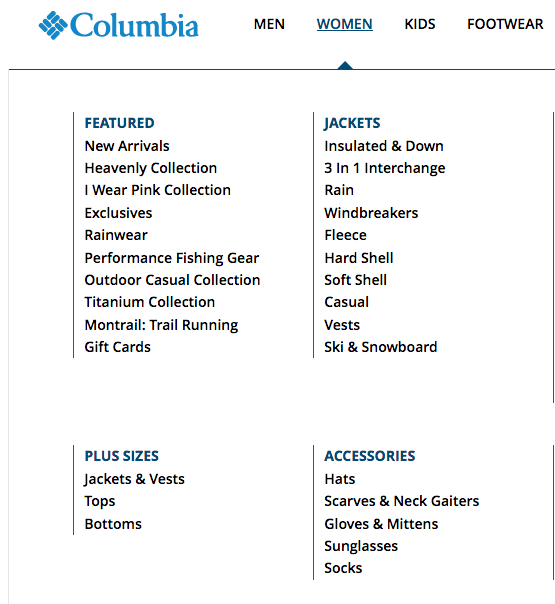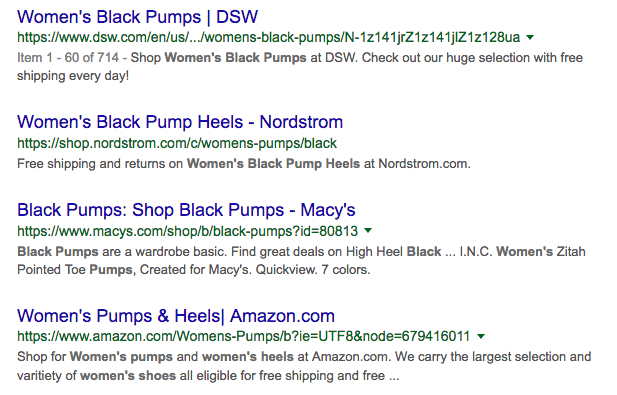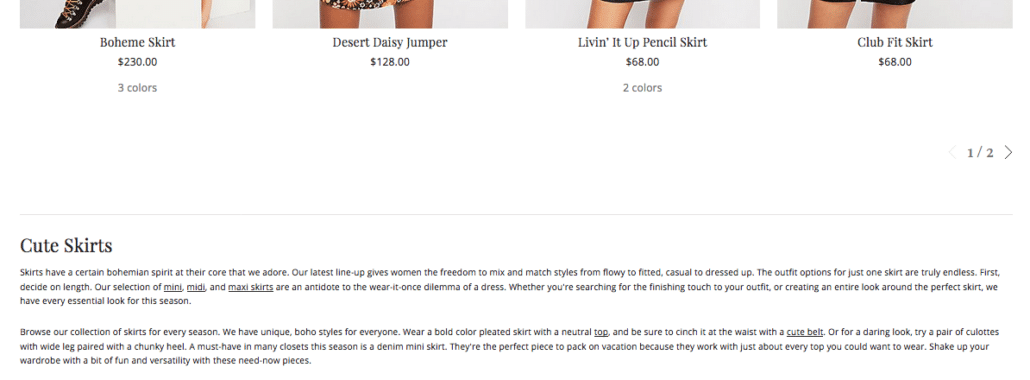We’ve observed that eCommerce websites usually spend a good portion of their SEO resources pushing individual product pages to the top of Google. As important as this is, you don’t want to overlook the many category pages that make up your eCommerce website.
With the right SEO strategy, you can move your category pages to the first page of Google for non-branded keywords. Not only can this increase traffic, but it also does wonders for building your brand.
What are eCommerce Category Pages?
Category pages are what makes up your eCommerce website’s taxonomy. Every item you sell can fit a certain category, usually: by type, by color, by material, or by style. Users use these categorizations to navigate through your site, while Search Engines use them to learn more about your products.
What’s an Example of an eCommerce Category?
If you sell shoes, here’s how you could categorize your website, and what the categories could be:
- By Type: High Heels, Boots, Pumps, Sandals.
- By Color: Black, White, Brown.
- By Material: Leather, Suede, Fiber.
- By Style: Vintage, Modern, Formal.
Columbia, for example, lays out its website as follows:

Upon running a Google search for a term such as “women’s jackets,” you’ll see the following:

As you can see, the title is optimized for a variety of high search volume keywords.
You can also mix and match certain product attributes to create more specific categories. For example, “women’s black pump shoes”.
Are categories good for SEO?
Category pages are great for SEO, especially – eCommerce SEO. In addition to adding structure to a website, they make it easier to rank for non-branded, product-related keywords.
If you have custom names for your products, let’s say – pumps that are called “Glossy Slingbacks”, they may rank for keywords in combination with the words “flats” or “clogs” instead of “pumps” because all of these shoes have slingbacks, and all of these shoes can be glossy. However, if you have a dedicated category for pumps, then Search Engines like Google will know instantly what your product actually is.
Aside from Search Engine semantics, categories are useful for users, as well. If users can instantly navigate your product offering to match exactly what they’re looking for, they’re more likely to proceed to conversion. On the flip-side, if customers can’t find your product, they won’t buy it. (Smashing Magazine).
Other than on-site navigation, it’s highly unlikely that customers look up products by specific names (unless they’re exclusively shopping for your brand). More often, what they type into search is the properties of an item that they would like to buy.
Here’s an example of several category pages at the top of Google for the keyword phrase “women’s black pump shoes.”

How do I optimize my eCommerce category pages?
When building and optimizing category pages, it’s important to do so with two things in mind:
- Keyword search demand
- Relevancy to your product catalog
With these details guiding you, its easier to build SEO-optimized eCommerce category pages, such as by optimizing titles to signal Google what keywords to rank the page for.
What are the Top Challenges?
The above gives you a basic overview of what you want to accomplish in regards to SEO for your category pages, however, there are some challenges.
For most eCommerce websites, the biggest challenge is that existing category pages primarily drive organic traffic from branded searches.
For example, only returning customers are able to find pages in Google by searching for something such as “Columbia windbreakers” or “Michael Kors crossbody bag.”

This is typically the result of category pages that are not fully optimized to rank on the first page of Google for non-branded keywords, such as “windbreakers” or “crossbody bag.”
What’s the Best Solution?
Above, we discussed the importance of including target keywords in the title. While this is an absolute must, don’t stop there.
There are other factors that contribute to Google’s ranking algorithm, with one of the strongest being keyword-targeted on-page content.
The best approach is to implement additional text at the bottom of each category page to provide a stronger signal to Google as to which keywords to rank the page for.
The technique of adding additional text on category pages is often overlooked by eCommerce websites, despite the fact that it can have a positive impact on organic search engine traffic.
It’s a common myth that category pages should only include titles, product images, and prices. You can take these pages to the next level by simply adding high-quality, informative content. Here’s an example:

It doesn’t take a lot of text. You can add SEO context to your eCommerce collection pages in just a few hundred words providing information such as:
- A description of the products on the page
- Internal links to similar products
- Advice on making a purchase.
By adding the target keyword and other variations in this text, you can optimize the page for search engines all without disrupting the user experience.
Making a few slight adjustments to your category pages, you increase the opportunity to rank on the first page for more non-branded keywords.

Subsequently, you’re in position to drive high quality, targeted traffic to your online store.
Looking for expert assistance when building out your product categories? Get a free consultation and SEO Opportunity Analysis today to see how Fire&Spark can help.

